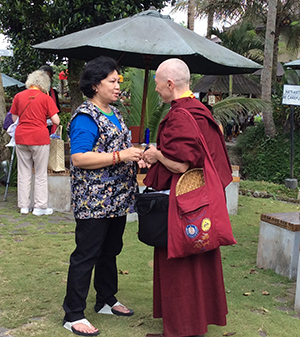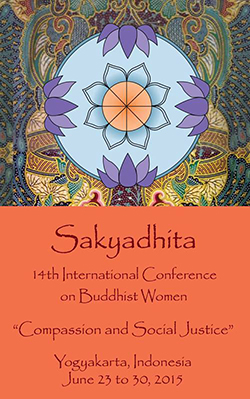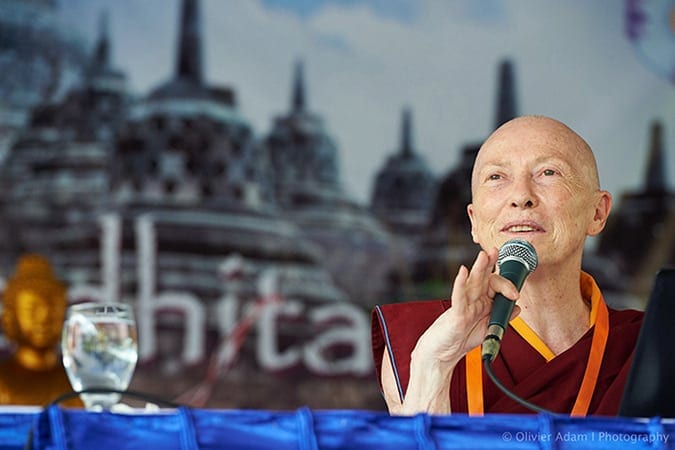Notes from the the 14th Sakyadhita Conference on Buddhist Women
By Teri SivilliYogyakarta, Indonesia
June 23, 2015
The iPhone has failed me. It doesn’t update the date and time on wireless networks, only on cellular. And so my phone was still on Tokyo time when I went to bed in Yogyakarta on the night of the solstice. Which means two things: it wasn’t 1 am when I went to sleep last night, merely 11 pm, and it is now 5:30 am, not 7:30 am, and I am 90 minutes early for breakfast. But I am happy to see the soft shadow play of dawn.
I have come to Yogyakarta for the 14th Sakyadhita Conference on Buddhist Women to present a paper on the Garrison Institute’s CBR Project. It has taken two days of mostly hassle-free travel from the U.S. to get here. I haven’t attended this conference before, and this is the first time the Institute will be represented. The other U.S. participants know of the Institute, and I answer questions about programs and retreats during meals.
It’s not just the mix of monastics and lay people that makes this conference unique, but also that it is not strictly academic and yet still adheres to a high level of rigor in the presentations. It’s a delicate balance to strike, between process and outcome, inclusion and rigor. Oh, and that this is a conference about women, produced by women, attended mostly by women. In contrast to many similar events, almost every presenter and participant is female. The multiplicity of traditions is expressed most vividly in the robes of the nuns: Vietnamese, Chinese, Japanese, Korean, Tibetan, Indonesian. A few men attend the conference, often accompanying their partners, and a few will present. They look adorable carrying the pandan bag that the conference provided: it’s tied with a batik bow.
 I wasn’t quite sure what to expect, coming here. While I myself practice in the Tibetan Buddhist tradition, I work at the intersection of secularized practices and science in the United States. I am only one of a handful of presenters at this conference working in this area, rather than in Buddhist studies. As a group, we are educating the others about the spread of secularized meditation practices in the west. In return, I am taking a deep dive into Buddhist scholarship and the ways that the dharma is applied in a variety of settings, including health care, education and prisons, in countries where the Buddhist origin of the teachings is appreciated.
I wasn’t quite sure what to expect, coming here. While I myself practice in the Tibetan Buddhist tradition, I work at the intersection of secularized practices and science in the United States. I am only one of a handful of presenters at this conference working in this area, rather than in Buddhist studies. As a group, we are educating the others about the spread of secularized meditation practices in the west. In return, I am taking a deep dive into Buddhist scholarship and the ways that the dharma is applied in a variety of settings, including health care, education and prisons, in countries where the Buddhist origin of the teachings is appreciated.
This is a gathering of scholars and practitioners, seeking to learn from each other. That women are struggling for full equality within Buddhist traditions is a given. There’s no point in debating the reality of history. We’re here celebrating the role of women in Buddhism.
Yesterday I sat with a professor from the U.S. who said she had avoided this event for many years, fearing it would be too “woo-woo.” It’s anything but “woo-woo.” And in contrast to many conferences, where people tend to stick to the tribe they came with, people are genuinely interested in reaching out, being welcoming. No one sits alone for long.
The conference days are long: presentations begin at 9 am, and the bus back to my hotel won’t leave until 8:30 pm. Thoughtfully, a rest area has been provided.
At the opening ceremonies, in the Governor’s Residence, Karma Lekshe Tsomo noted that 1,000 people have gathered from 40 countries for the conference, representing all of the Buddhist traditions, working together in harmony. “Never in the world have we been more in need of the qualities of compassion and social justice, as intolerance, violence, and cruelty increase.”
 “All spiritual paths help us curb the darkness inside, and to cultivate the good,” she continued. “No spiritual tradition does not inculcate goodness. When we adopt the form of spiritual practice without working for inner transformation, the essence is lost.”
“All spiritual paths help us curb the darkness inside, and to cultivate the good,” she continued. “No spiritual tradition does not inculcate goodness. When we adopt the form of spiritual practice without working for inner transformation, the essence is lost.”
“When we have 1,000 women together, let the voice of sanity and compassion be heard. In this century, finally, the voice of women is being heard.”
In her keynote address, she explored what we mean by compassion, what we mean by social justice, and how these two are related.
Buddhism defines compassion as the wish for others to be free from suffering, while love is the wish for other beings to be happy. The first step in generating compassion, clearly, is to be aware of the suffering of living being. This is the first connection to social justice: understanding that a great deal of the suffering in the world comes from the simple fact that we don’t all have equal resources and opportunities. According to the UN, 60% of the work in the world is done by women, but they only hold 20% of the world’s wealth, and 1% of its land.
Economic justice is an aspect of social justice. We will need just governments, just processes, and to have women’s voices represented equally in governments.
Many Buddhists are compassionate and generous, but social justice isn’t about giving rice to the poor. It’s about changing the structures that keep people poor. No one knows exactly how many people in the world practice Buddhism; the estimate is 600 million, which means there are 300 million female Buddhists. That’s a huge potential force for good.
Photo by Oliver Adam
